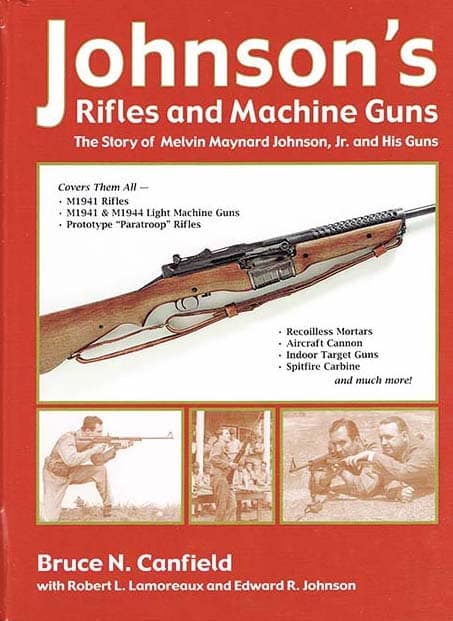By Dean Roxby

Johnson’s Rifles and Machine Guns: The Story of Melvin Maynard Johnson, Jr. and His Guns
Although overshadowed by the far better known M1 Garand service rifle, the story of the Johnson M1941 rifle is an interesting part of U.S. military history.
Melvin Johnson was the driving force behind the M1941 semiautomatic rifle and the M1941 Light Machine Gun (LMG). This book, by noted U.S. weapons expert and author Bruce N. Canfield, covers the development and use of these arms, as well as other lesser known products.
Canfield, best known for several books on the M1 Garand rifle and M1 Carbine, profiles Johnson the man and the Johnson Automatics company, as well as his rifle and LMG. As the name suggests, this book covers the man as least as much as the guns he developed. Canfield was given access to an unpublished 600-page manuscript that Johnson had assembled over 4 years, documenting his life. (Johnson actually submitted Unpardonable Guns to a book publisher, but it was rejected.) Canfield also worked with Melvin Johnson’s second son Edward R. Johnson. This access allows Canfield to go deep into the history and struggles of the rifle selection process, the busy times during World War II and the lean times following the War. The book follows this timeline, being broken into three parts.
Part I—History and Development
Starting with the usual family history introduction, the book follows the early development of the semiauto rifle, the forming of Johnson Automatics, Inc., and the testing at Aberdeen Proving Ground in Maryland. The development of the full-auto LMG (eventually named the M1941 LMG) is covered also. A little known experimental gun called the Auto-Carbine is also profiled. It was essentially a much shortened Johnson semiauto rifle. It kept the .30-06 cartridge, so had nothing to do with the Winchester-designed M1 Carbine.
Part II—World War II–Betsy and Emma Go to War
The subtitle refers to Johnson’s habit of giving his designs female names. The M1941 rifle was “Betsy,” and the LMG was “Emma.” (The Auto-Carbine mentioned above was named “Daisy Mae.”) While the U.S. Army did not adopt any of Johnson’s designs, the USMC First Parachute Battalion did acquire a small number of Betsys and Emmas that saw action in the Pacific. The purchase of rifles for the Netherlands East Indies (now known as Indonesia) is covered, as is the transfer of rifles to the USMC after the East Indies were overrun by the Japanese forces.
Lesser known projects during WWII are examined, such as a 20mm aircraft cannon (nicknamed “Bertha”), a takedown paratroop model of the rifle, and even a prototype of a recoilless mortar. An updated version of the M1941 LMG is also covered; this became the M1944, and with further improvements, it became the M1945.
Near the end of the War, Johnson Automatics, Inc., was given a contract to study the feasibility of motorizing an 1880s-era Gatling gun. After buying an original Model 1886, 10-barrel Gatling chambered in .45-70 Govt., an electric motor was attached, and some amazing rates of fire were reached. A peak of 5,800 RPM is noted.
Part III—Post-War
With the end of the War, came lean times for Johnson Automatics, Inc., as most militaries were downsizing. In order to keep busy, they began sporterizing military surplus bolt-action rifles for the commercial market. They also introduced a low-powered BB gun, the Johnson Indoor Target Gun. (On a personal note, I placed an ad in the old Shotgun News classified ad magazine years ago, looking for various airgun pellet tins, as I collect them. I got a phone call from one of Melvin Johnson’s sons offering me a package of JITG BBs. I still have the sealed package.) The JITG used a rubber tube as the power source. It had enough velocity to tear paper targets but not enough to pierce the cardboard box it came in. The box was used as a backstop and BB catcher. During a promo event, an attractive young model dressed in party balloons acted as a live target! However, the gun lacked the power to burst the balloons, much to the shooter’s frustration. This was planned, to show how low-powered it was. (Don’t try this at home, kids!)
In late 1948, Johnson Automatics declared bankruptcy, and an auction was held in March 1949. Johnson himself went to work for Winchester Repeating Arms following this. He worked there until 1954. Eventually, he joined Armalite, a division of Fairchild Aircraft. During this time, Armalite was working on the AR-10 rifle. Several features of the AR-10 were reminiscent of the Johnson semiauto rifle, including the straight-line stock, the multiple locking lugs on the bolt and the use of a barrel extension that the bolt locked up to.
The book relates a comical anecdote during this time. Johnson was verbally explaining something to an Armalite engineer. The engineer wanted Mel to draw it out on paper, but Johnson preferred to draw it out in cigar smoke!
Also during the mid-1950s, Johnson was involved with the Dardick Corp. and their unique triangular-shaped “trounds.” This was for a short-lived pistol that was sort of a magazine-fed revolver. When this ended, Johnson then began converting .30-caliber M1 Carbines to 5.7mm (.224 cal). This wildcat cartridge used a .30 carbine case necked down to .224 diameter. It became known as the MMJ 5.7mm Johnson Spitfire. It had modest success but never really took off.
The book ends with several pages of collector notes. As the Johnson rifles are becoming very valuable now, it is vital that collectors know what to look for, to avoid getting burned by fakers.
This is a very well-researched book that gives a detailed look into the life and times of an inventor, as well as his various guns. If you are in the market for an M1941 rifle, you would be well-served by this book. Numerous detail photos of the innards, several photos of the factory machine shops and period advertising make this a worthwhile book.
- By Bruce N. Canfield, with Robert L. Lamoreaux and Edward R. Johnson
- Mowbray Publishing
- ISBN 1-931464-02-2
- Copyright 2002, 2006
- Hardcover, 8.5” x 11”, 272 pages, 285+ color and B&W photos
- MSRP: $49.95
- gunandswordcollector.com
- Available direct from Mowbray
| This article first appeared in Small Arms Review V24N3 (March 2020) |











